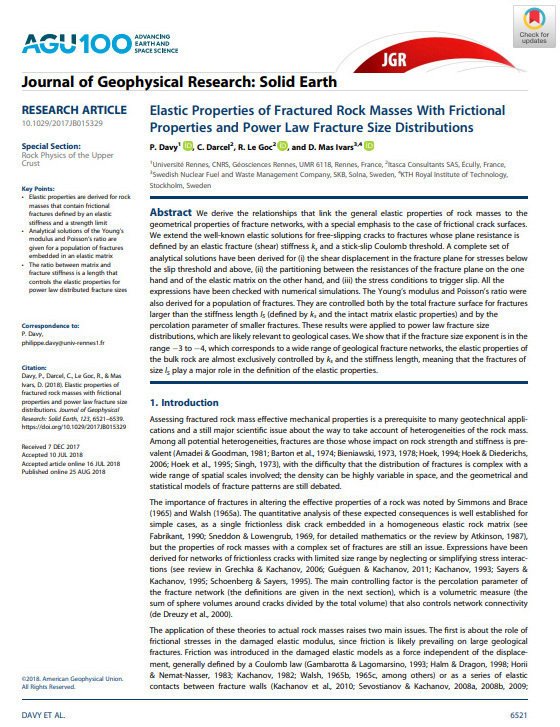Elastic Properties of Fractured Rock Masses With Frictional Properties and Power Law Fracture Size Distributions
Davy, P.1, Darcel, C.2, Le Goc, R.2, & Mas Ivars, D.3,4
1.Université Rennes, CNRS, Géosciences Rennes, UMR 6118, Rennes, France,
2.Itasca Consultants SAS, Écully, France,
3.Swedish Nuclear Fuel and Waste Management Company, SKB, Solna, Sweden,
4.KTH Royal Institute of Technology,Stockholm, Sweden
Davy, P., Darcel, C., Le Goc, R., & Mas Ivars, D. (2018). Elastic Properties of Fractured Rock Masses With Frictional Properties and Power Law Fracture Size Distributions. Journal of Geophysical Research: Solid Earth. doi:10.1029/2017jb015329
Abstract
We derive the relationships that link the general elastic properties of rock masses to the geometrical properties of fracture networks, with a special emphasis to the case of frictional crack surfaces. We extend the well-known elastic solutions for free-slipping cracks to fractures whose plane resistance is defined by an elastic fracture (shear) stiffness ks and a stick-slip Coulomb threshold.
A complete set of analytical solutions have been derived for (i) the shear displacement in the fracture plane for stresses below the slip threshold and above, (ii) the partitioning between the resistances of the fracture plane on the one hand and of the elastic matrix on the other hand, and (iii) the stress conditions to trigger slip. All the expressions have been checked with numerical simulations. The Young’s modulus and Poisson’s ratio were also derived for a population of fractures. They are controlled both by the total fracture surface for fractures larger than the stiffness length lS (defined by ks and the intact matrix elastic properties) and by the percolation parameter of smaller fractures. These results were applied to power law fracture size distributions, which are likely relevant to geological cases. We show that if the fracture size exponent is in the range 3 to 4, which corresponds to a wide range of geological fracture networks, the elastic properties of the bulk rock are almost exclusively controlled by ks and the stiffness length, meaning that the fractures of size lS play a major role in the definition of the elastic properties.
Keywords: Rock mass, DFN, elastic properties

